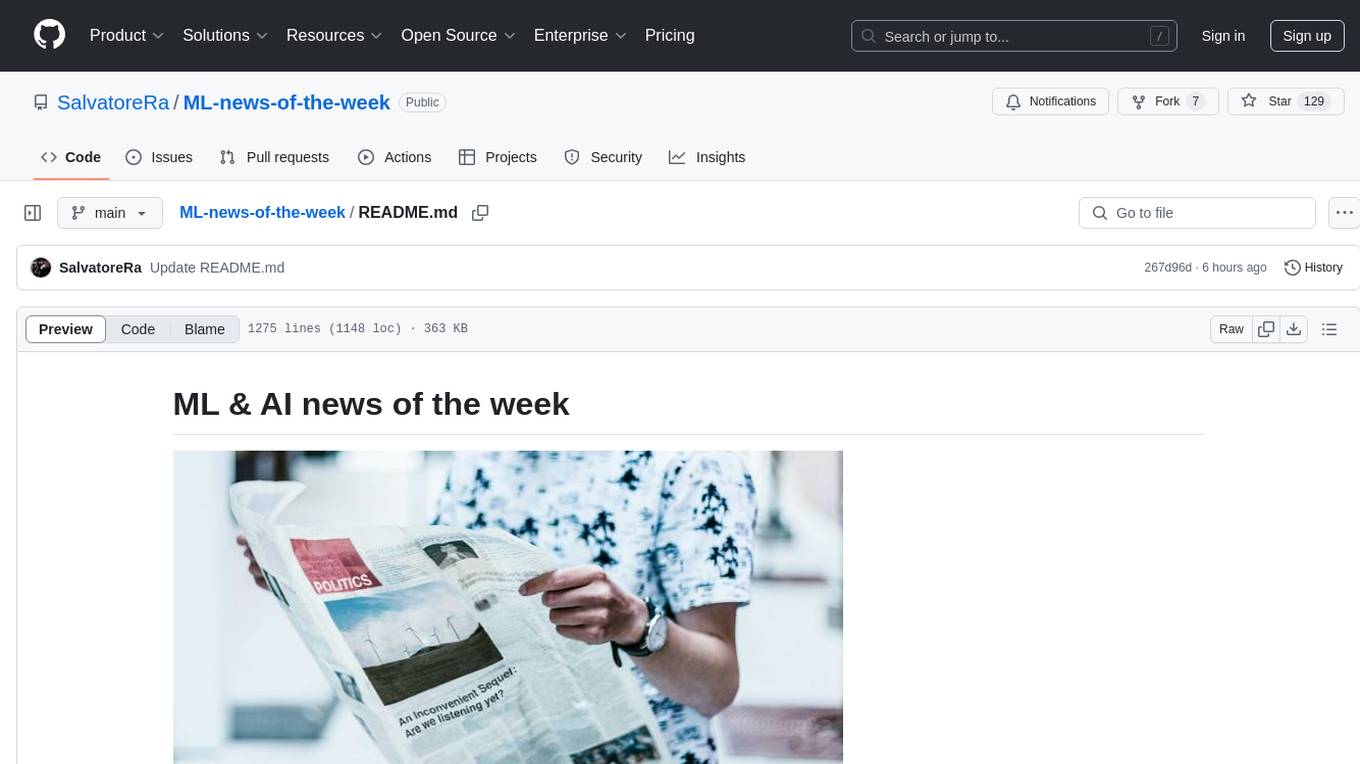
learn-generative-ai
Learn Cloud Applied Generative AI Engineering (GenEng) using OpenAI, Gemini, Streamlit, Containers, Serverless, Postgres, LangChain, Pinecone, and Next.js
Stars: 592
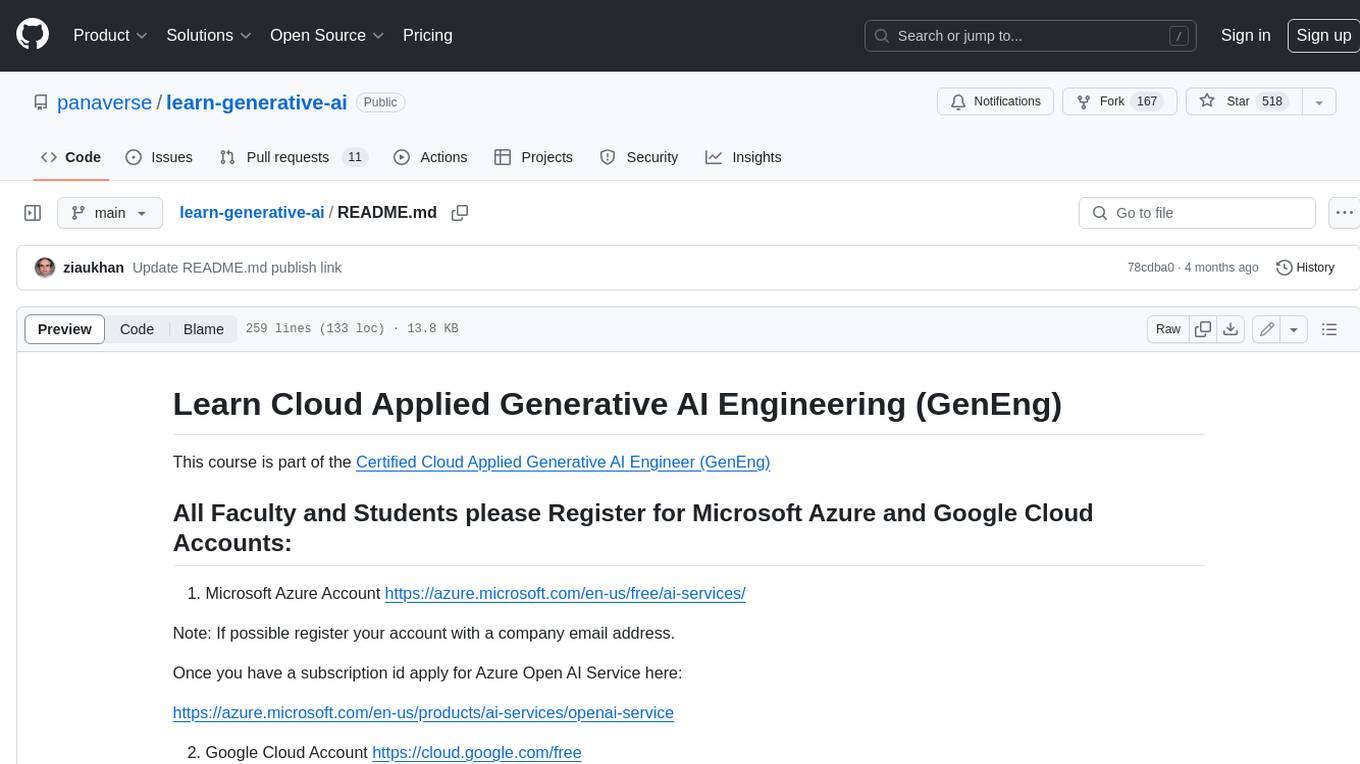
Learn Cloud Applied Generative AI Engineering (GenEng) is a course focusing on the application of generative AI technologies in various industries. The course covers topics such as the economic impact of generative AI, the role of developers in adopting and integrating generative AI technologies, and the future trends in generative AI. Students will learn about tools like OpenAI API, LangChain, and Pinecone, and how to build and deploy Large Language Models (LLMs) for different applications. The course also explores the convergence of generative AI with Web 3.0 and its potential implications for decentralized intelligence.
README:
This course is part of the Certified Cloud Applied Generative AI Engineer (GenEng)
- Microsoft Azure Account https://azure.microsoft.com/en-us/free/ai-services/
Note: If possible register your account with a company email address.
Once you have a subscription id apply for Azure Open AI Service here:
https://azure.microsoft.com/en-us/products/ai-services/openai-service
- Google Cloud Account https://cloud.google.com/free
From Microsoft to MIT MBA, the AI reeducation boot camp is coming for every worker and executive
Nvidia says generative AI will be bigger than the internet
Generative AI and Its Economic Impact: What You Need to Know
Must Read: OpenAI DevDay - a pivotal moment for AI
GenEng revolution being led by developers who build deep proficiency in how to best leverage and integrate generative AI technologies into applications
There is a clear separation of roles between those that create and train models (Data Scientists and Engineers) and those who use those models (Developers). This was already on the way, and it much clearer with the GenAI revolution - the future of the GenAI will be determined on how it will be driven to adoption - and it will be driven by how developers adopt it.
GenEng practitioners will need to have many of the same skills of traditional application development, including scalable architecting, integrating enterprise systems, and understanding requirements from the business user. These skills will be augmented with the nuances of building generative AI applications, such as involving the business domain experts in validating aspects of prompt engineering and choosing the right LLM based on price/performance and outcomes
The rise of GenEng: How AI changes the developer role
Google launches its largest and ‘most capable’ AI model, Gemini
Meta, IBM and Intel join alliance for open AI development while Google and Microsoft sit out
Sam Altman to return as CEO of OpenAI
The Year in Tech, 2024: The Insights You Need from Harvard Business Review
The Year in Tech 2024: The Insights You Need about Generative AI and Web 3.0 from Harvard Business Review will help you understand what the latest and most important tech innovations mean for your organization and how you can use them to compete and win in today's turbulent business environment. Business is changing. Will you adapt or be left behind? Get up to speed and deepen your understanding of the topics that are shaping your company's future with the Insights You Need from Harvard Business Review series. You can't afford to ignore how these issues will transform the landscape of business and society. The Insights You Need series will help you grasp these critical ideas--and prepare you and your company for the future.
McKinsey Technology Trends Outlook 2023
Watch Introduction to Generative AI
-
McKinsey: The economic potential of generative AI: The next productivity frontier, McKinsey Digital report, June 2023
-
GPTs are GPTs: An Early Look at the Labor Market Impact Potential of Large Language Models, Tyna Eloundou, Sam Manning, Pamela Miskin, and Daniel Rock, March 2023 (arXiv:2303.10130)
-
Goldman Sachs: The Potentially Large Effects of Artificial Intelligence on Economic Growth, Joseph Briggs and Devesh Kodnani, March 2023
OpenAI API is a collection of APIs
APIs offer access to various Large Language Models (LLMs)
LLM: Program trained to understand human language
ChatGPT is a web service using the Chat completion API Uses:
- gpt-3.5-turbo (free tier)
- gpt-4.0 (paid tier)
-
Chat completion: Given a series of messages, generate a response
-
Function calling: Choose which function to call
-
Image generation: Given a text description generate an image
-
Speech to text: Given an audio file and a prompt generate a transcript
-
Fine tuning: Train a model using input and output examples
The new Assistants API is a stateful evolution of Chat Completions API meant to simplify the creation of assistant-like experiences, and enable developer access to powerful tools like Code Interpreter and Retrieval.
The primitives of the Chat Completions API are Messages, on which you perform a Completion with a Model (gpt-3.5-turbo, gpt-4, etc). It is lightweight and powerful, but inherently stateless, which means you have to manage conversation state, tool definitions, retrieval documents, and code execution manually.
The primitives of the Assistants API are
- Assistants, which encapsulate a base model, instructions, tools, and (context) documents,
- Threads, which represent the state of a conversation, and
- Runs, which power the execution of an Assistant on a Thread, including textual responses and multi-step tool use.
The OPL Stack stands for OpenAI, Pinecone, and Langchain. It's a collection of open-source tools and libraries that make building and deploying LLMs a breeze.
“AI will be the greatest wealth creator in history because artificial intelligence doesn’t care where you were born, whether you have money, whether you have a PhD,” Higgins tells CNBC Make It. “It’s going to destroy barriers that have prevented people from moving up the ladder, and pursuing their dream of economic freedom.”
It’s already valued at almost $100 billion, and expected to contribute $15.7 trillion to the global economy by 2030.
“It’s not that if you don’t jump on it now, you never can,” Higgins says. “It’s that now is the greatest opportunity for you to capitalize on it.”
A.I. will be the biggest wealth creator in history
Generative AI could add up to $4.4 trillion annually to the global economy
Silicon Valley Sees a New Kind of Mobile Device Powered by GenAI
Microsoft CEO: AI is "bigger than the PC, bigger than mobile" - but is he right?
Artificial General Intelligence Is Already Here
Inside the race to build an ‘operating system’ for generative AI
Business intelligence in the era of GenAI
The Convergence of AI and Web3: A New Era of Decentralized Intelligence
What is the potential of Generative AI and Web 3.0 when combined?
How Web3 Can Unleash the Power of Generative AI
- Generative AI with LangChain: Build large language model (LLM) apps with Python, ChatGPT and other LLMs
- LangChain Crash Course: Build OpenAI LLM powered Apps
- Build and Learn: AI App Development for Beginners: Unleashing ChatGPT API with LangChain & Streamlit
- Generative AI in Healthcare - The ChatGPT Revolution
- Generative AI in Accounting Guide: Explore the possibilities of generative AI in accounting
- Using Generative AI in Business Whitepaper
- Generative AI: what accountants need to know in 2023
- 100 Practical Applications and Use Cases of Generative AI
LangChain Explained in 13 Minutes | QuickStart Tutorial for Beginners
LangChain Crash Course for Beginners
LangChain Crash Course for Beginners Video
LangChain for LLM Application Development
LangChain: Chat with Your Data
A Gentle Intro to Chaining LLMs, Agents, and Utils via LangChain
The LangChain Cookbook - Beginner Guide To 7 Essential Concepts
Greg Kamradt’s LangChain Youtube Playlist
1littlecoder LangChain Youtube Playlist
Pinecone
https://docs.pinecone.io/docs/quickstart
https://python.langchain.com/docs/integrations/vectorstores/pinecone
LangChain - Vercel AI SDK
https://sdk.vercel.ai/docs/guides/providers/langchain
Using Python and Flask in Next.js 13 API
https://github.com/wpcodevo/nextjs-flask-framework
https://vercel.com/templates/python/flask-hello-world
https://vercel.com/docs/functions/serverless-functions/runtimes/python
https://codevoweb.com/how-to-integrate-flask-framework-with-nextjs/#google_vignette
https://github.com/vercel/examples/tree/main/python
https://github.com/orgs/vercel/discussions/2732
https://flask.palletsprojects.com/en/2.3.x/tutorial/
https://flask.palletsprojects.com/en/2.3.x/
Reference Material:
Top 5 Resources to learn LangChain
Official LangChain YouTube channel
Building Custom Q&A Applications Using LangChain and Pinecone Vector Database
End to End LLM Project Using Langchain | NLP Project End to End
Build and Learn: AI App Development for Beginners: Unleashing ChatGPT API with LangChain & Streamlit
Total Questions: 40
Duration: 60 minutes
For Tasks:
Click tags to check more tools for each tasksFor Jobs:
Alternative AI tools for learn-generative-ai
Similar Open Source Tools

learn-generative-ai
Learn Cloud Applied Generative AI Engineering (GenEng) is a course focusing on the application of generative AI technologies in various industries. The course covers topics such as the economic impact of generative AI, the role of developers in adopting and integrating generative AI technologies, and the future trends in generative AI. Students will learn about tools like OpenAI API, LangChain, and Pinecone, and how to build and deploy Large Language Models (LLMs) for different applications. The course also explores the convergence of generative AI with Web 3.0 and its potential implications for decentralized intelligence.
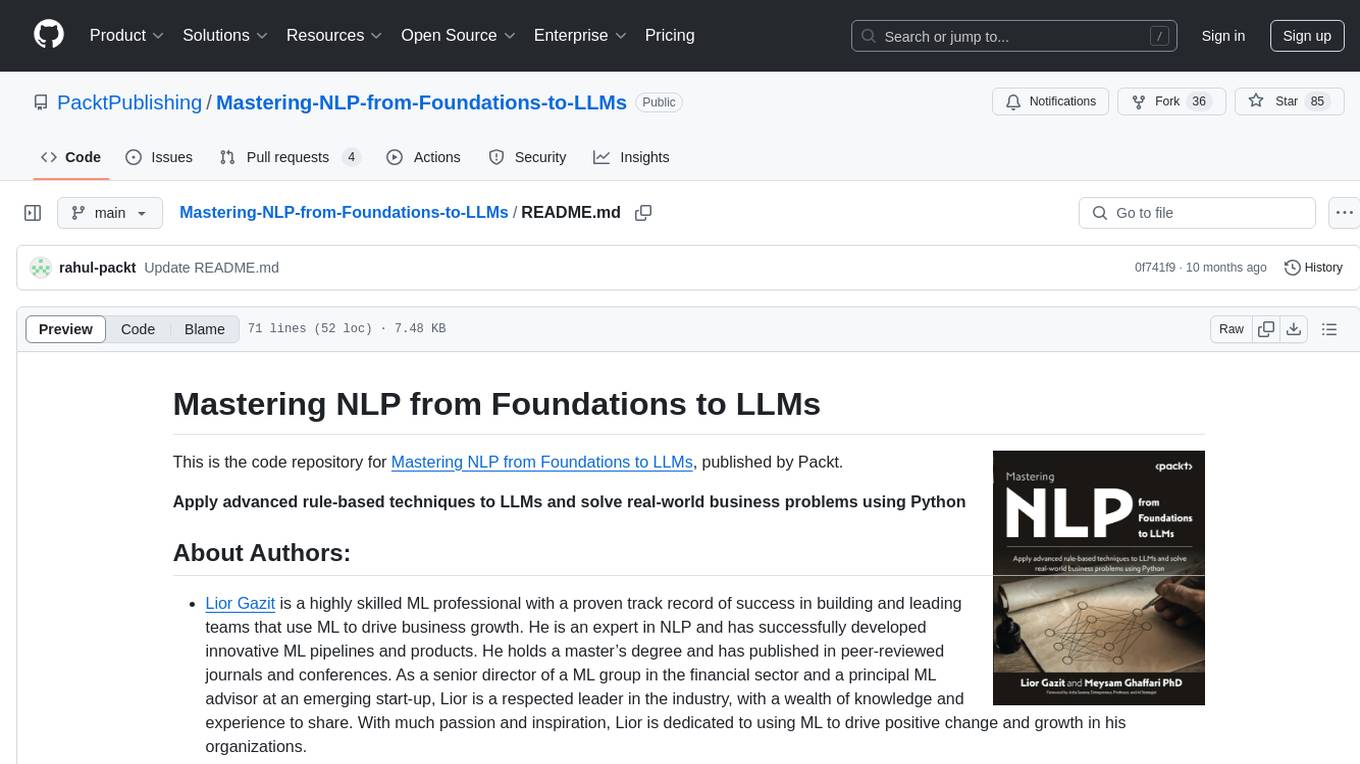
Mastering-NLP-from-Foundations-to-LLMs
This code repository is for the book 'Mastering NLP from Foundations to LLMs', which provides an in-depth introduction to Natural Language Processing (NLP) techniques. It covers mathematical foundations of machine learning, advanced NLP applications such as large language models (LLMs) and AI applications, as well as practical skills for working on real-world NLP business problems. The book includes Python code samples and expert insights into current and future trends in NLP.
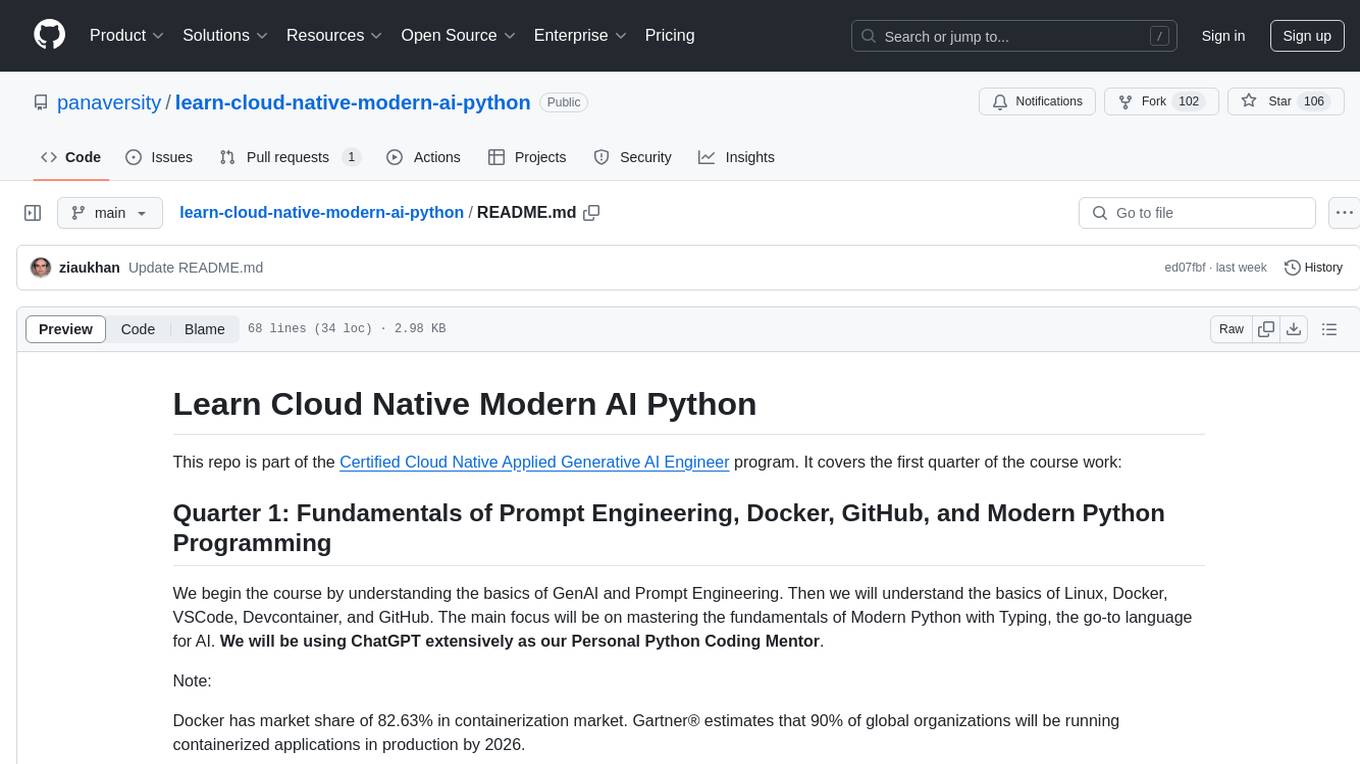
learn-cloud-native-modern-ai-python
This repository is part of the Certified Cloud Native Applied Generative AI Engineer program, focusing on the fundamentals of Prompt Engineering, Docker, GitHub, and Modern Python Programming. It covers the basics of GenAI, Linux, Docker, VSCode, Devcontainer, and GitHub. The main emphasis is on mastering Modern Python with Typing, using ChatGPT as a Personal Python Coding Mentor. The course material includes tools installation, study materials, and projects related to Python development in Docker containers and GitHub usage.
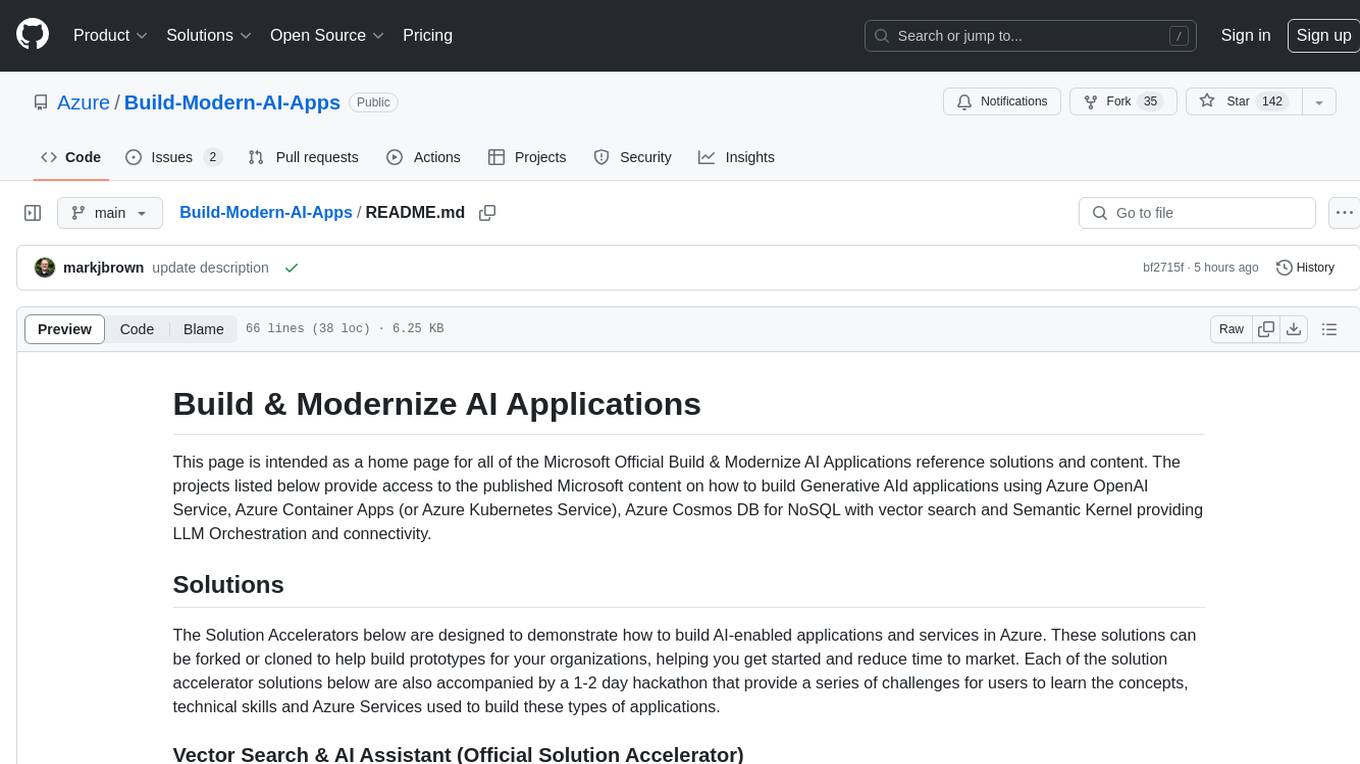
Build-Modern-AI-Apps
This repository serves as a hub for Microsoft Official Build & Modernize AI Applications reference solutions and content. It provides access to projects demonstrating how to build Generative AI applications using Azure services like Azure OpenAI, Azure Container Apps, Azure Kubernetes, and Azure Cosmos DB. The solutions include Vector Search & AI Assistant, Real-Time Payment and Transaction Processing, and Medical Claims Processing. Additionally, there are workshops like the Intelligent App Workshop for Microsoft Copilot Stack, focusing on infusing intelligence into traditional software systems using foundation models and design thinking.
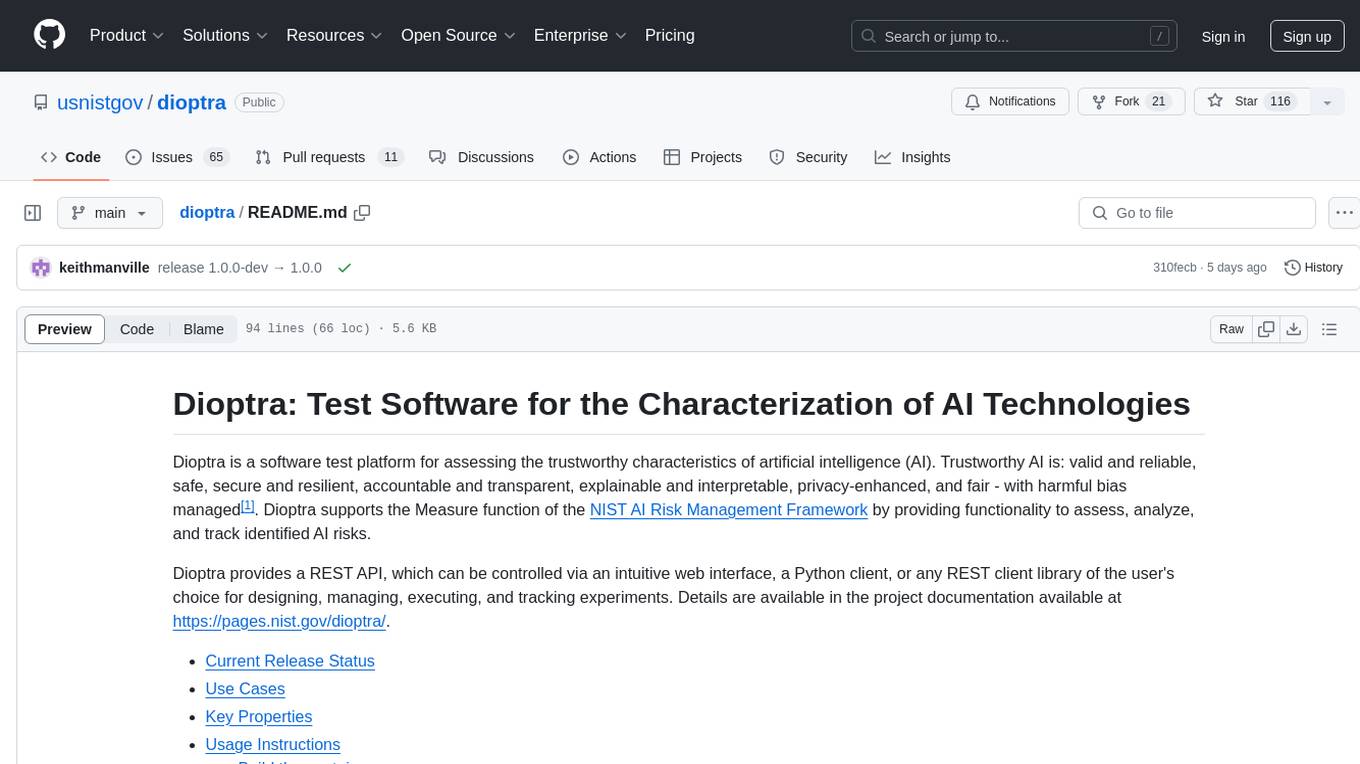
dioptra
Dioptra is a software test platform for assessing the trustworthy characteristics of artificial intelligence (AI). It supports the NIST AI Risk Management Framework by providing functionality to assess, analyze, and track identified AI risks. Dioptra provides a REST API and can be controlled via a web interface or Python client for designing, managing, executing, and tracking experiments. It aims to be reproducible, traceable, extensible, interoperable, modular, secure, interactive, shareable, and reusable.
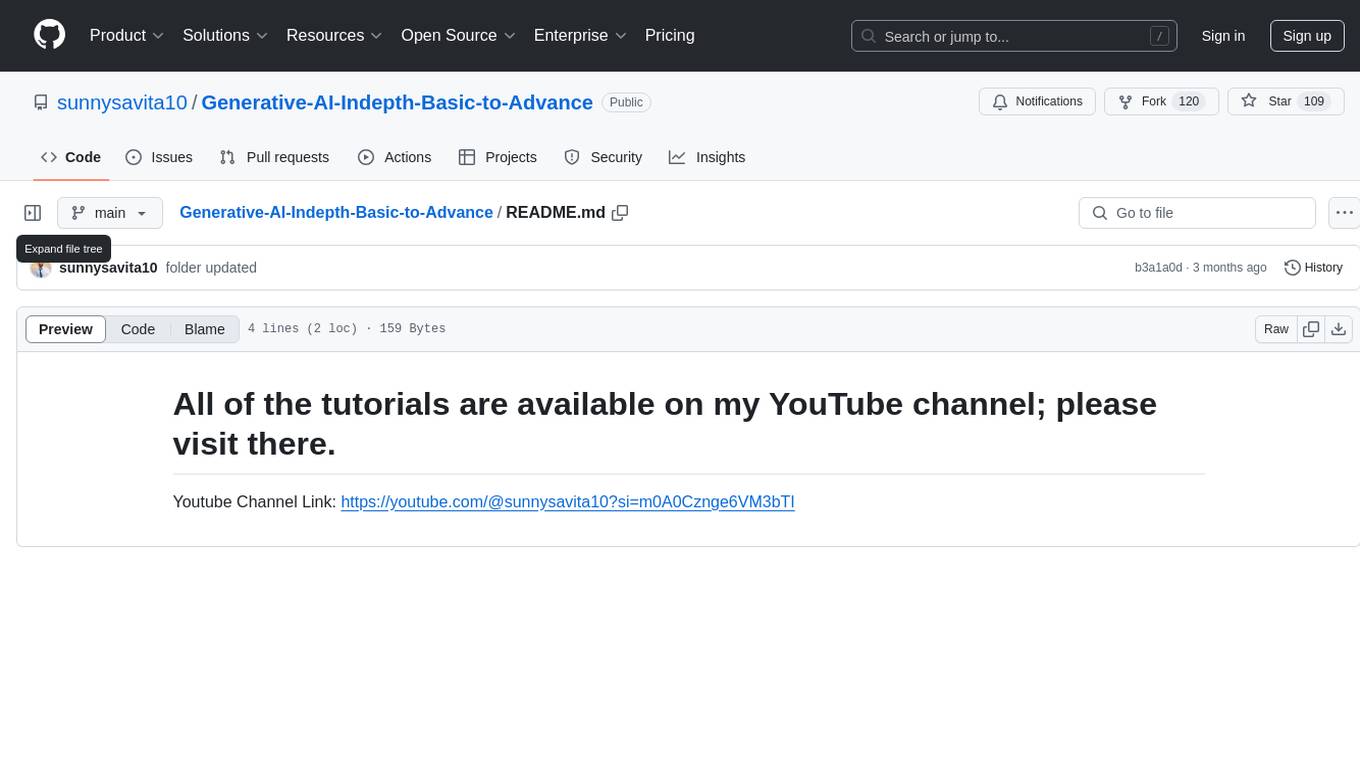
Generative-AI-Indepth-Basic-to-Advance
Generative AI Indepth Basic to Advance is a repository focused on providing tutorials and resources related to generative artificial intelligence. The repository covers a wide range of topics from basic concepts to advanced techniques in the field of generative AI. Users can find detailed explanations, code examples, and practical demonstrations to help them understand and implement generative AI algorithms. The goal of this repository is to help beginners get started with generative AI and to provide valuable insights for more experienced practitioners.
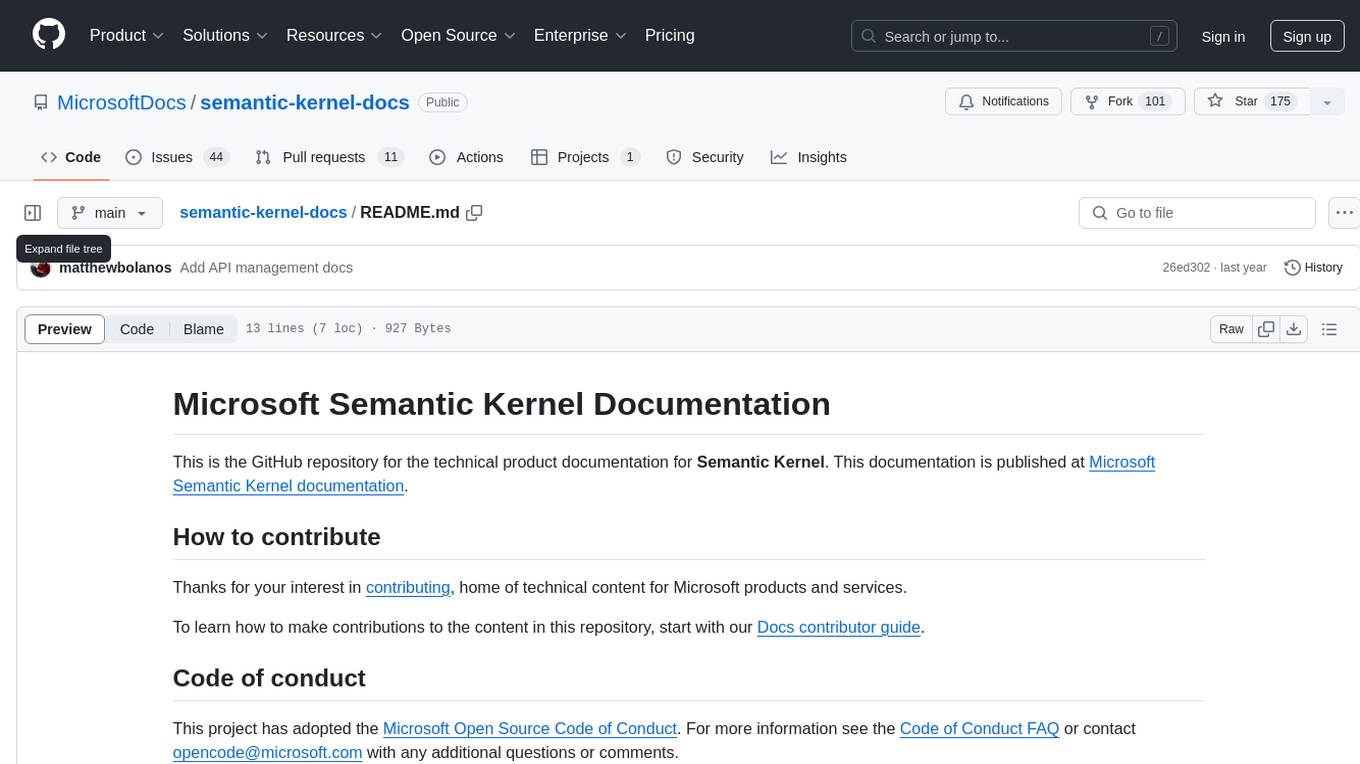
semantic-kernel-docs
The Microsoft Semantic Kernel Documentation GitHub repository contains technical product documentation for Semantic Kernel. It serves as the home of technical content for Microsoft products and services. Contributors can learn how to make contributions by following the Docs contributor guide. The project follows the Microsoft Open Source Code of Conduct.
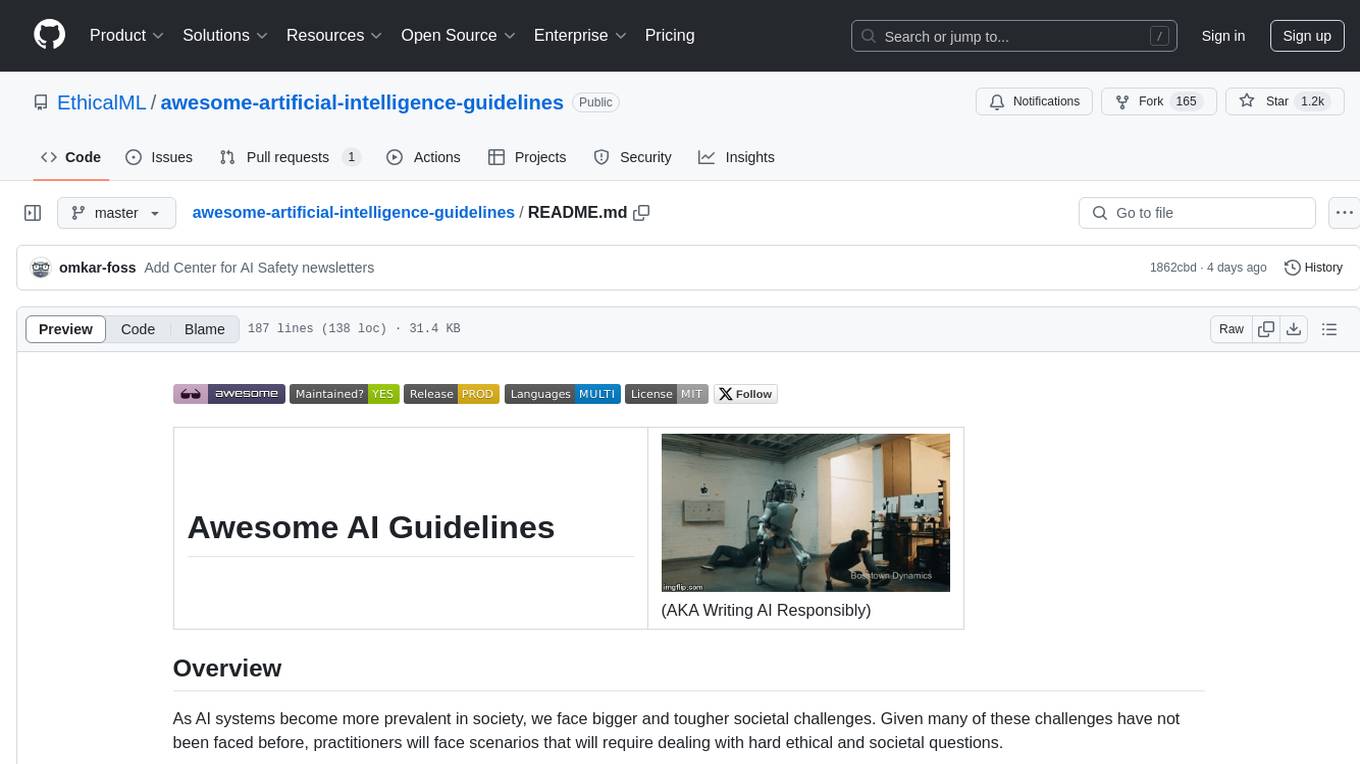
awesome-artificial-intelligence-guidelines
The 'Awesome AI Guidelines' repository aims to simplify the ecosystem of guidelines, principles, codes of ethics, standards, and regulations around artificial intelligence. It provides a comprehensive collection of resources addressing ethical and societal challenges in AI systems, including high-level frameworks, principles, processes, checklists, interactive tools, industry standards initiatives, online courses, research, and industry newsletters, as well as regulations and policies from various countries. The repository serves as a valuable reference for individuals and teams designing, building, and operating AI systems to navigate the complex landscape of AI ethics and governance.

Lecture_AI_in_Automotive_Technology
This Github repository contains practice session materials for the TUM course on Artificial Intelligence in Automotive Technology. It includes coding examples used in the lectures to teach the foundations of AI in automotive technology. The repository aims to provide hands-on experience and practical knowledge in applying AI concepts to the automotive industry.
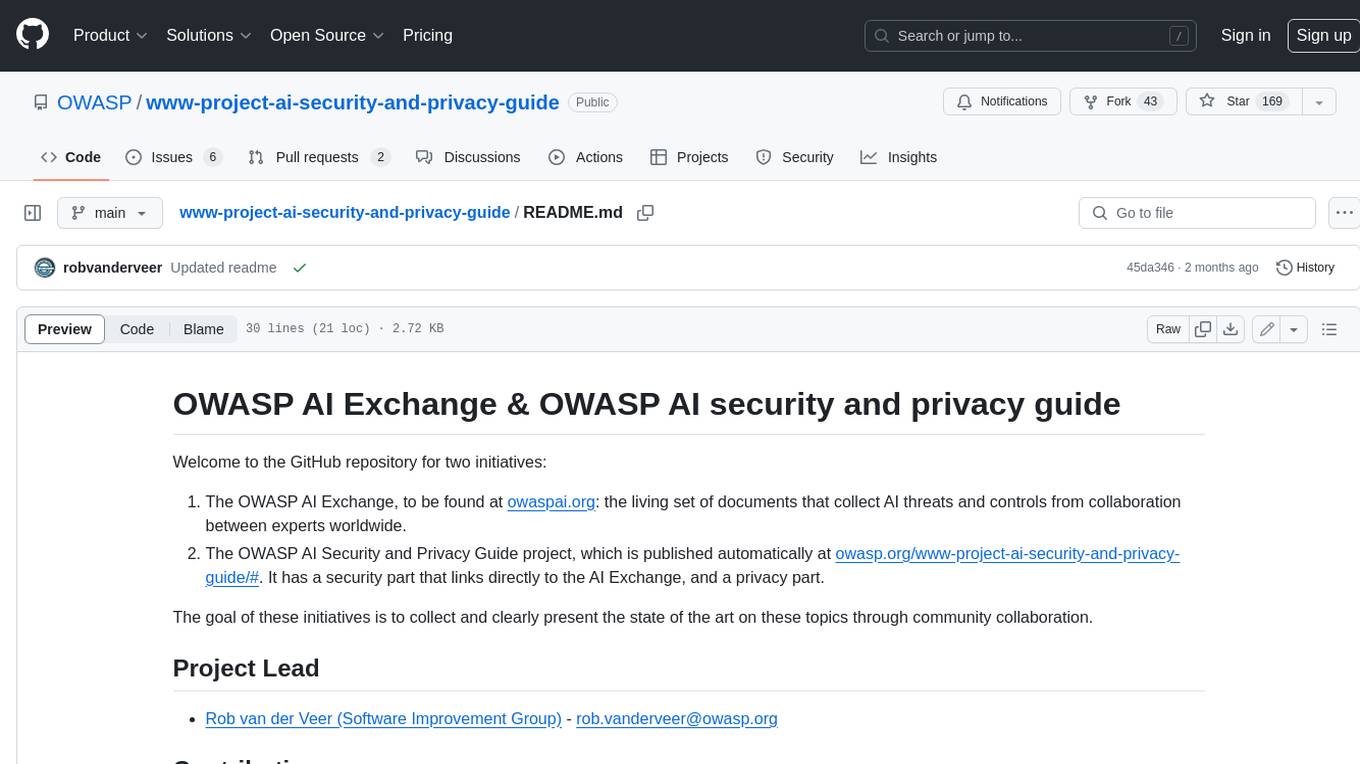
www-project-ai-security-and-privacy-guide
The OWASP AI Exchange and OWASP AI security and privacy guide are initiatives to collect and present the state of the art on AI threats, controls, security, and privacy through community collaboration. The AI Exchange is a living set of documents that collect AI threats and controls from collaboration between experts worldwide. The AI Security and Privacy Guide project has a security part that links directly to the AI Exchange, and a privacy part.
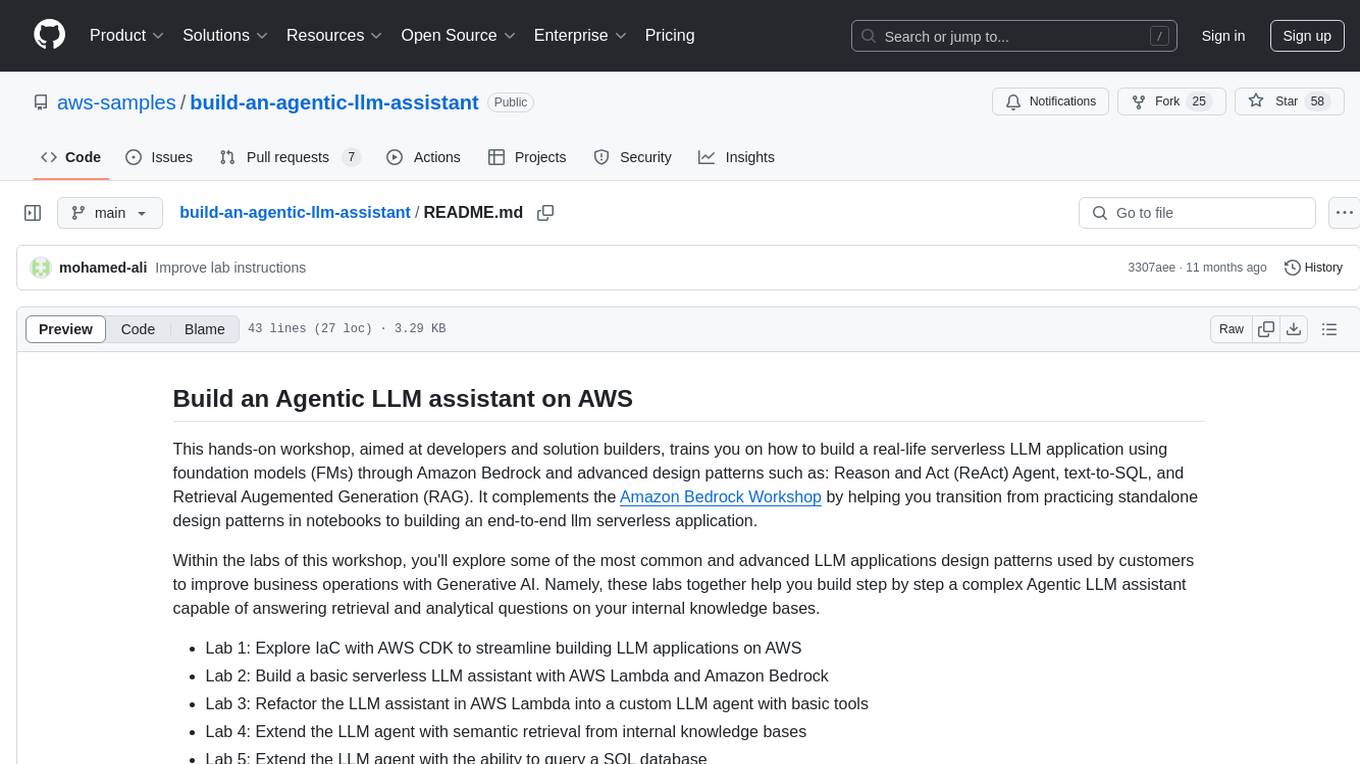
build-an-agentic-llm-assistant
This repository provides a hands-on workshop for developers and solution builders to build a real-life serverless LLM application using foundation models (FMs) through Amazon Bedrock and advanced design patterns such as Reason and Act (ReAct) Agent, text-to-SQL, and Retrieval Augmented Generation (RAG). It guides users through labs to explore common and advanced LLM application design patterns, helping them build a complex Agentic LLM assistant capable of answering retrieval and analytical questions on internal knowledge bases. The repository includes labs on IaC with AWS CDK, building serverless LLM assistants with AWS Lambda and Amazon Bedrock, refactoring LLM assistants into custom agents, extending agents with semantic retrieval, and querying SQL databases. Users need to set up AWS Cloud9, configure model access on Amazon Bedrock, and use Amazon SageMaker Studio environment to run data-pipelines notebooks.
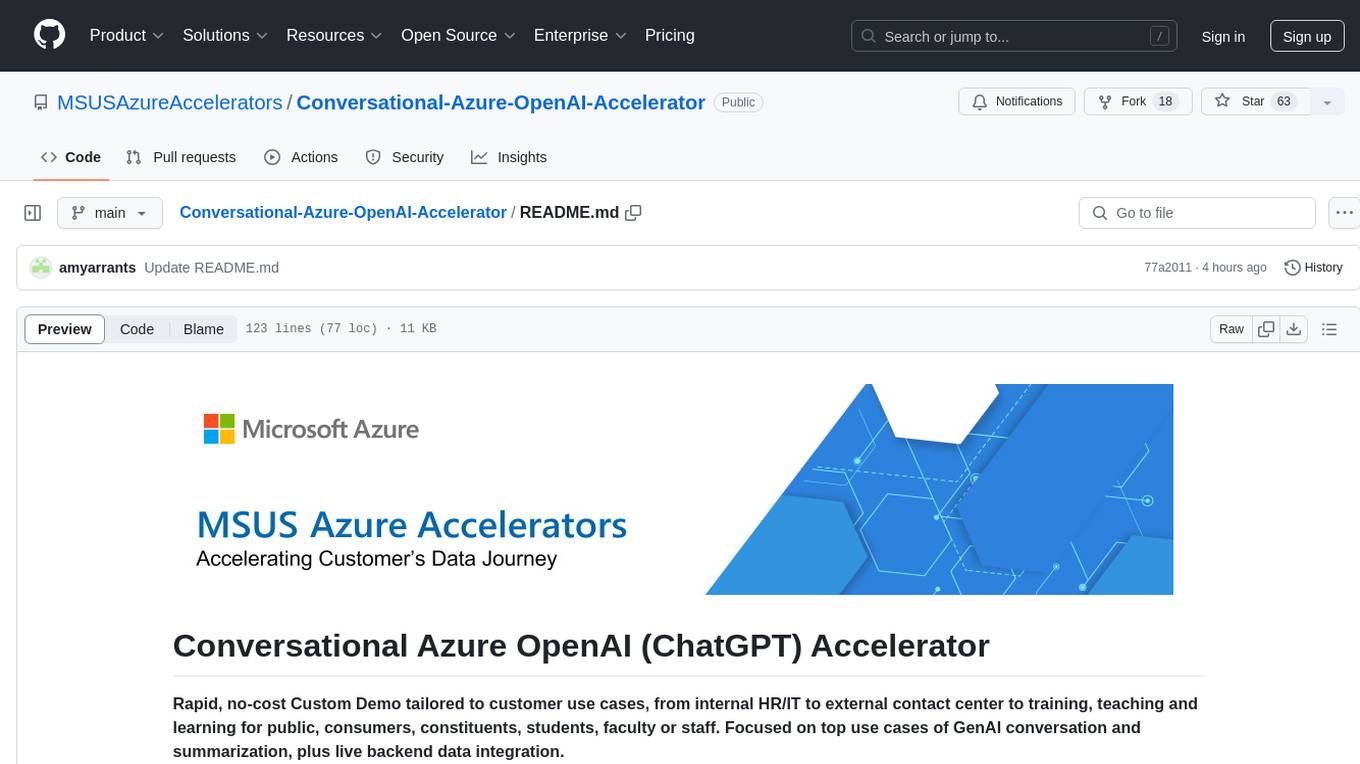
Conversational-Azure-OpenAI-Accelerator
The Conversational Azure OpenAI Accelerator is a tool designed to provide rapid, no-cost custom demos tailored to customer use cases, from internal HR/IT to external contact centers. It focuses on top use cases of GenAI conversation and summarization, plus live backend data integration. The tool automates conversations across voice and text channels, providing a valuable way to save money and improve customer and employee experience. By combining Azure OpenAI + Cognitive Search, users can efficiently deploy a ChatGPT experience using web pages, knowledge base articles, and data sources. The tool enables simultaneous deployment of conversational content to chatbots, IVR, voice assistants, and more in one click, eliminating the need for in-depth IT involvement. It leverages Microsoft's advanced AI technologies, resulting in a conversational experience that can converse in human-like dialogue, respond intelligently, and capture content for omni-channel unified analytics.
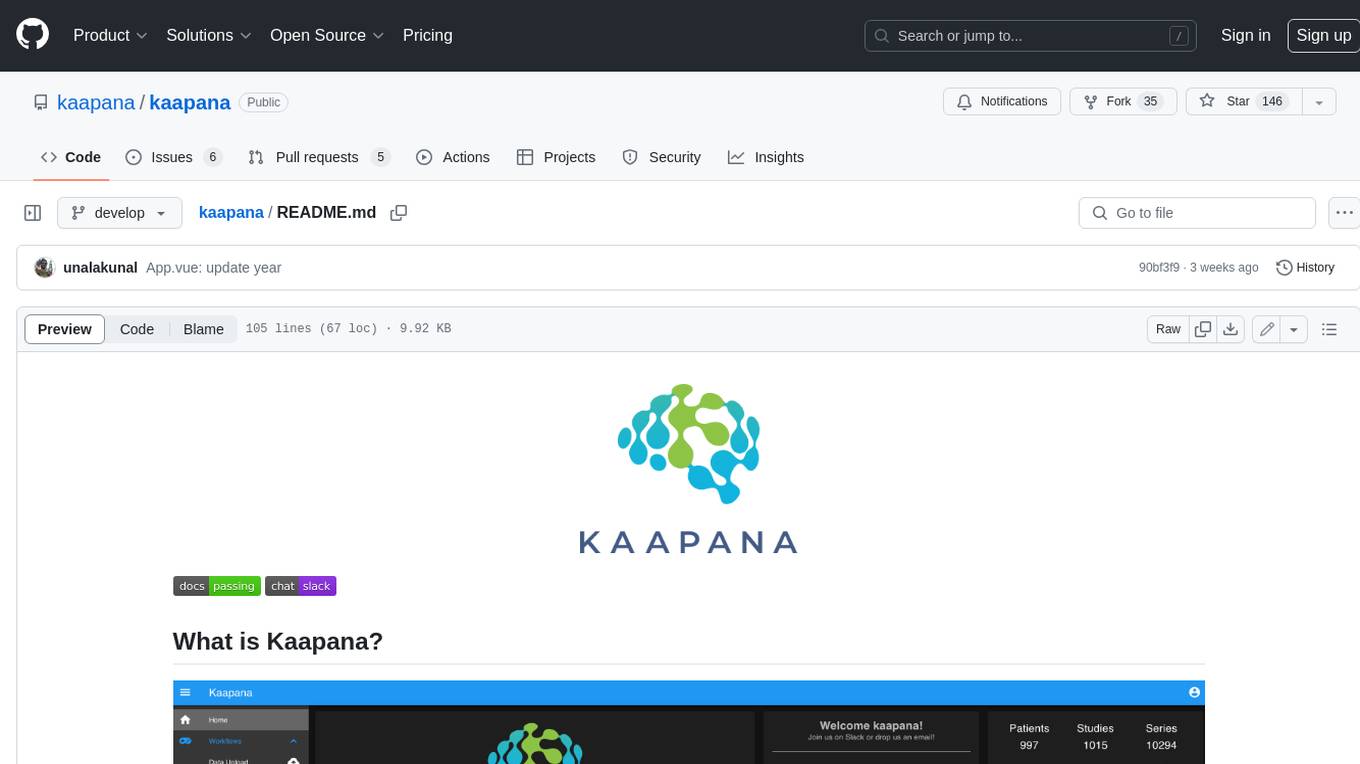
kaapana
Kaapana is an open-source toolkit for state-of-the-art platform provisioning in the field of medical data analysis. The applications comprise AI-based workflows and federated learning scenarios with a focus on radiological and radiotherapeutic imaging. Obtaining large amounts of medical data necessary for developing and training modern machine learning methods is an extremely challenging effort that often fails in a multi-center setting, e.g. due to technical, organizational and legal hurdles. A federated approach where the data remains under the authority of the individual institutions and is only processed on-site is, in contrast, a promising approach ideally suited to overcome these difficulties. Following this federated concept, the goal of Kaapana is to provide a framework and a set of tools for sharing data processing algorithms, for standardized workflow design and execution as well as for performing distributed method development. This will facilitate data analysis in a compliant way enabling researchers and clinicians to perform large-scale multi-center studies. By adhering to established standards and by adopting widely used open technologies for private cloud development and containerized data processing, Kaapana integrates seamlessly with the existing clinical IT infrastructure, such as the Picture Archiving and Communication System (PACS), and ensures modularity and easy extensibility.
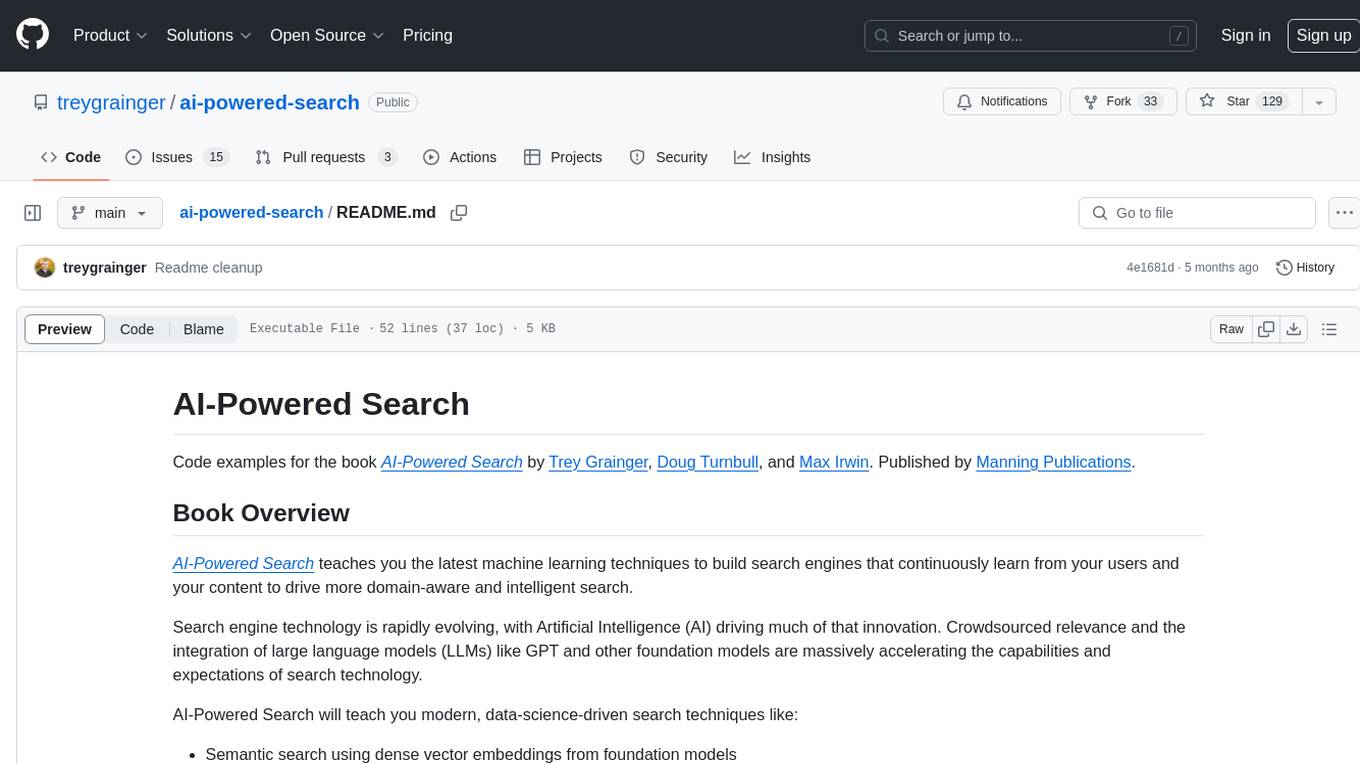
ai-powered-search
AI-Powered Search provides code examples for the book 'AI-Powered Search' by Trey Grainger, Doug Turnbull, and Max Irwin. The book teaches modern machine learning techniques for building search engines that continuously learn from users and content to deliver more intelligent and domain-aware search experiences. It covers semantic search, retrieval augmented generation, question answering, summarization, fine-tuning transformer-based models, personalized search, machine-learned ranking, click models, and more. The code examples are in Python, leveraging PySpark for data processing and Apache Solr as the default search engine. The repository is open source under the Apache License, Version 2.0.
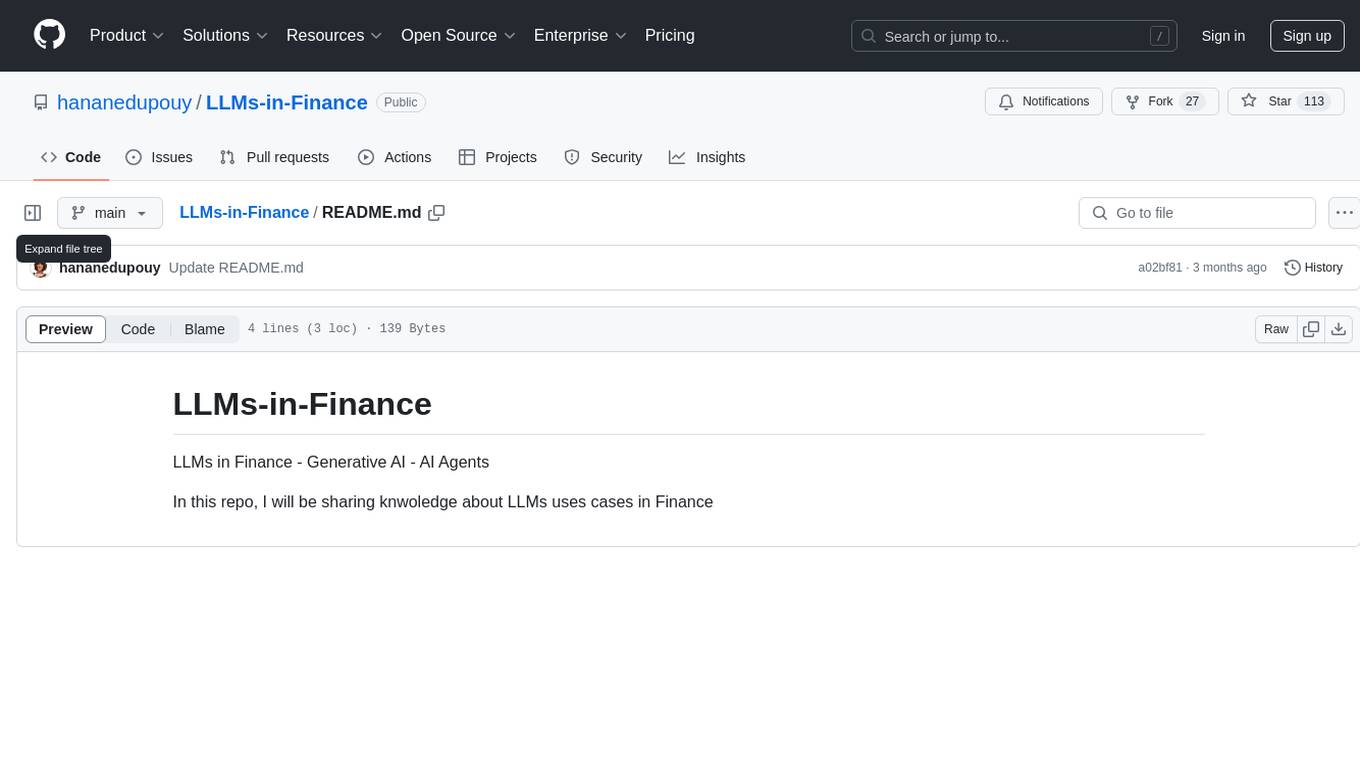
LLMs-in-Finance
This repository focuses on the application of Large Language Models (LLMs) in the field of finance. It provides insights and knowledge about how LLMs can be utilized in various scenarios within the finance industry, particularly in generating AI agents. The repository aims to explore the potential of LLMs to enhance financial processes and decision-making through the use of advanced natural language processing techniques.
For similar tasks

learn-generative-ai
Learn Cloud Applied Generative AI Engineering (GenEng) is a course focusing on the application of generative AI technologies in various industries. The course covers topics such as the economic impact of generative AI, the role of developers in adopting and integrating generative AI technologies, and the future trends in generative AI. Students will learn about tools like OpenAI API, LangChain, and Pinecone, and how to build and deploy Large Language Models (LLMs) for different applications. The course also explores the convergence of generative AI with Web 3.0 and its potential implications for decentralized intelligence.
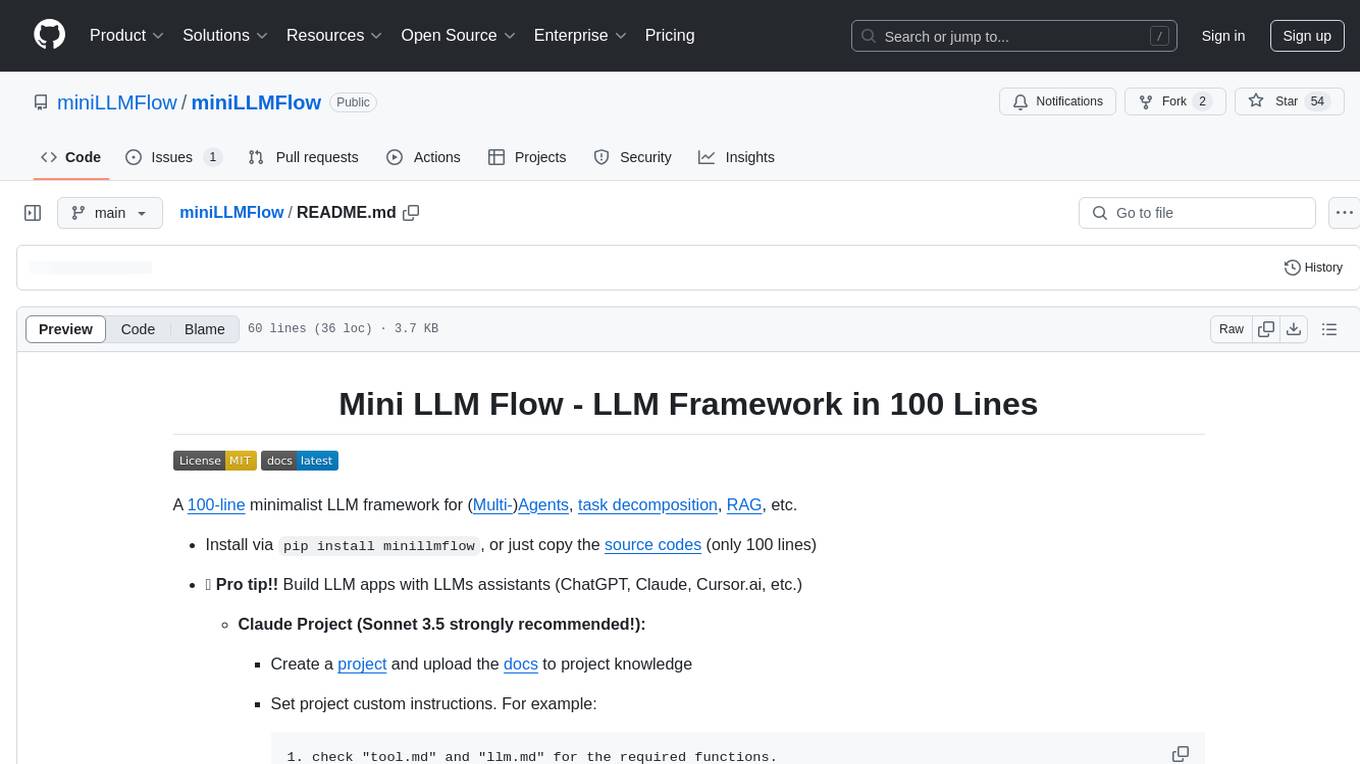
miniLLMFlow
Mini LLM Flow is a 100-line minimalist LLM framework designed for agents, task decomposition, RAG, etc. It aims to be the framework used by LLMs, focusing on high-level programming paradigms while stripping away low-level implementation details. It serves as a learning resource and allows LLMs to design, build, and maintain projects themselves.
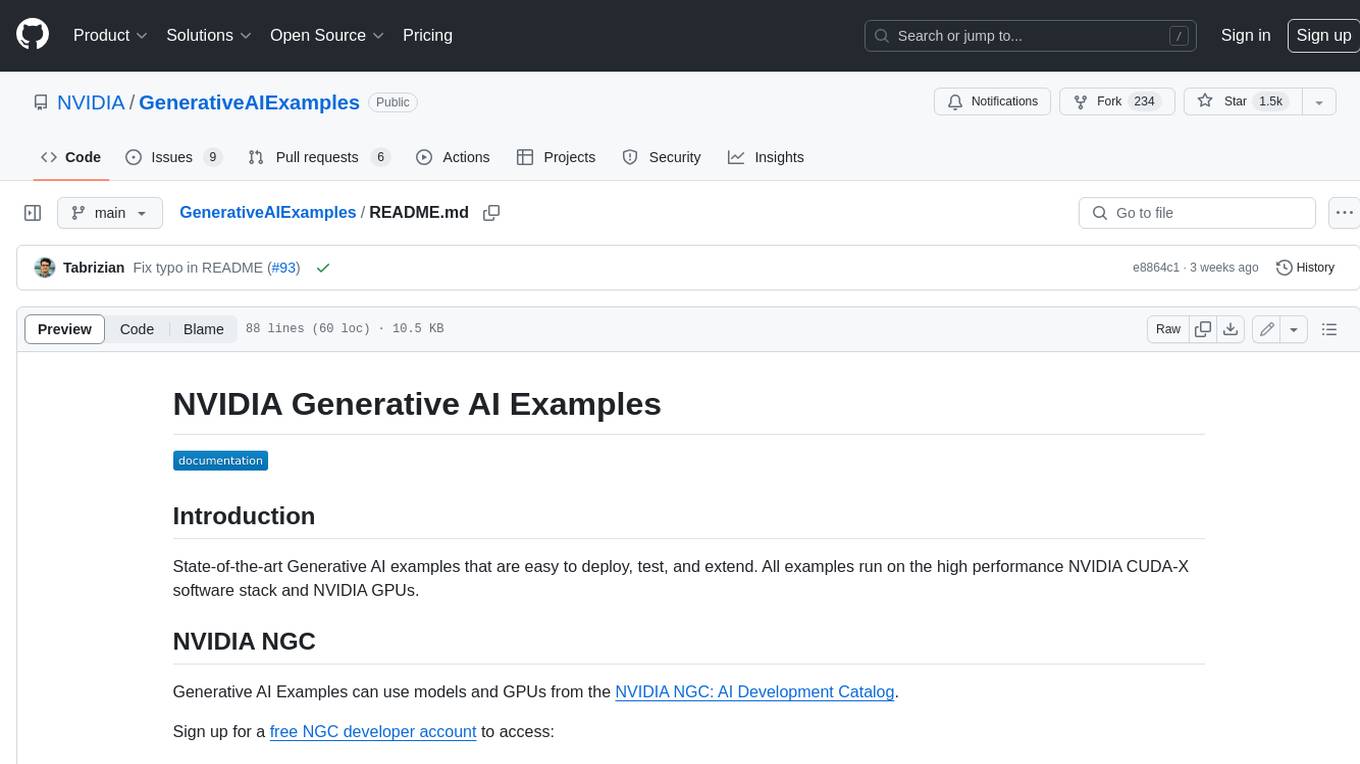
GenerativeAIExamples
NVIDIA Generative AI Examples are state-of-the-art examples that are easy to deploy, test, and extend. All examples run on the high performance NVIDIA CUDA-X software stack and NVIDIA GPUs. These examples showcase the capabilities of NVIDIA's Generative AI platform, which includes tools, frameworks, and models for building and deploying generative AI applications.

zep-python
Zep is an open-source platform for building and deploying large language model (LLM) applications. It provides a suite of tools and services that make it easy to integrate LLMs into your applications, including chat history memory, embedding, vector search, and data enrichment. Zep is designed to be scalable, reliable, and easy to use, making it a great choice for developers who want to build LLM-powered applications quickly and easily.
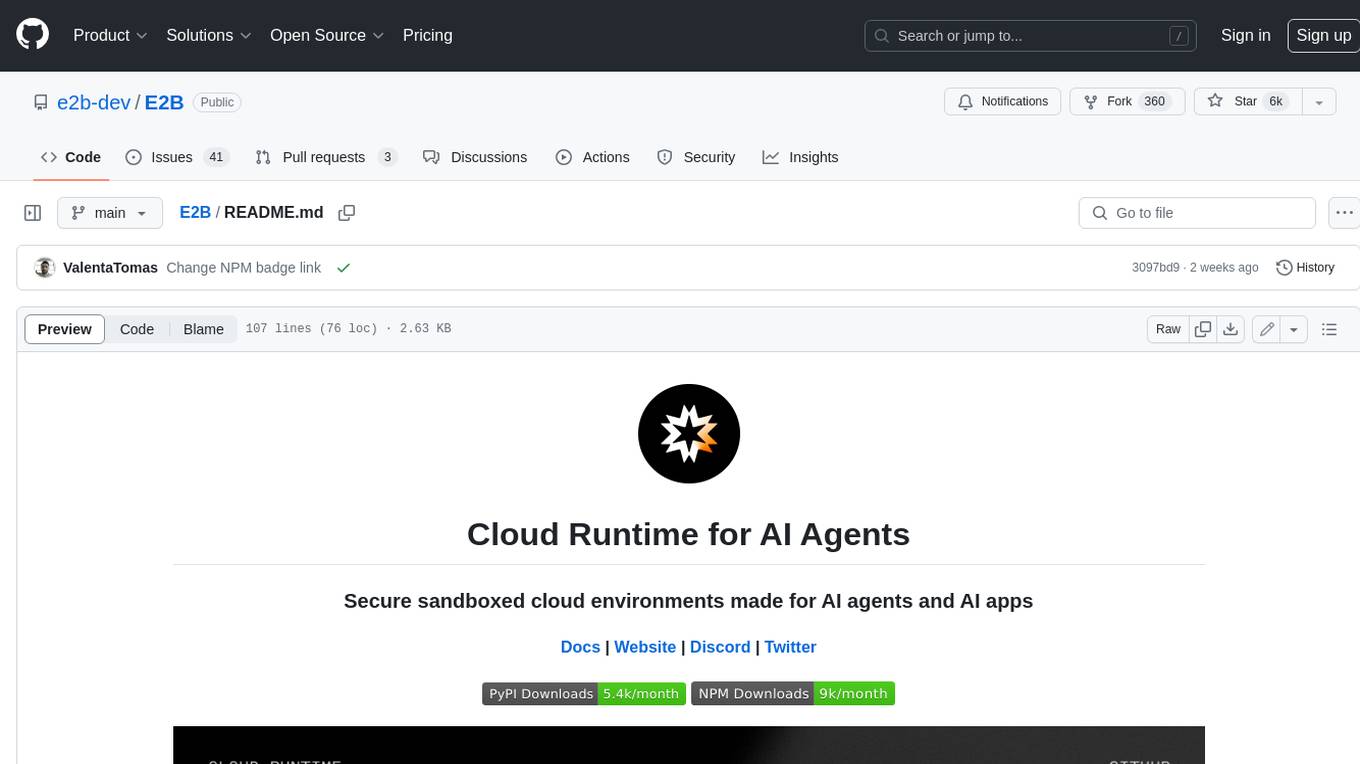
E2B
E2B Sandbox is a secure sandboxed cloud environment made for AI agents and AI apps. Sandboxes allow AI agents and apps to have long running cloud secure environments. In these environments, large language models can use the same tools as humans do. For example: * Cloud browsers * GitHub repositories and CLIs * Coding tools like linters, autocomplete, "go-to defintion" * Running LLM generated code * Audio & video editing The E2B sandbox can be connected to any LLM and any AI agent or app.
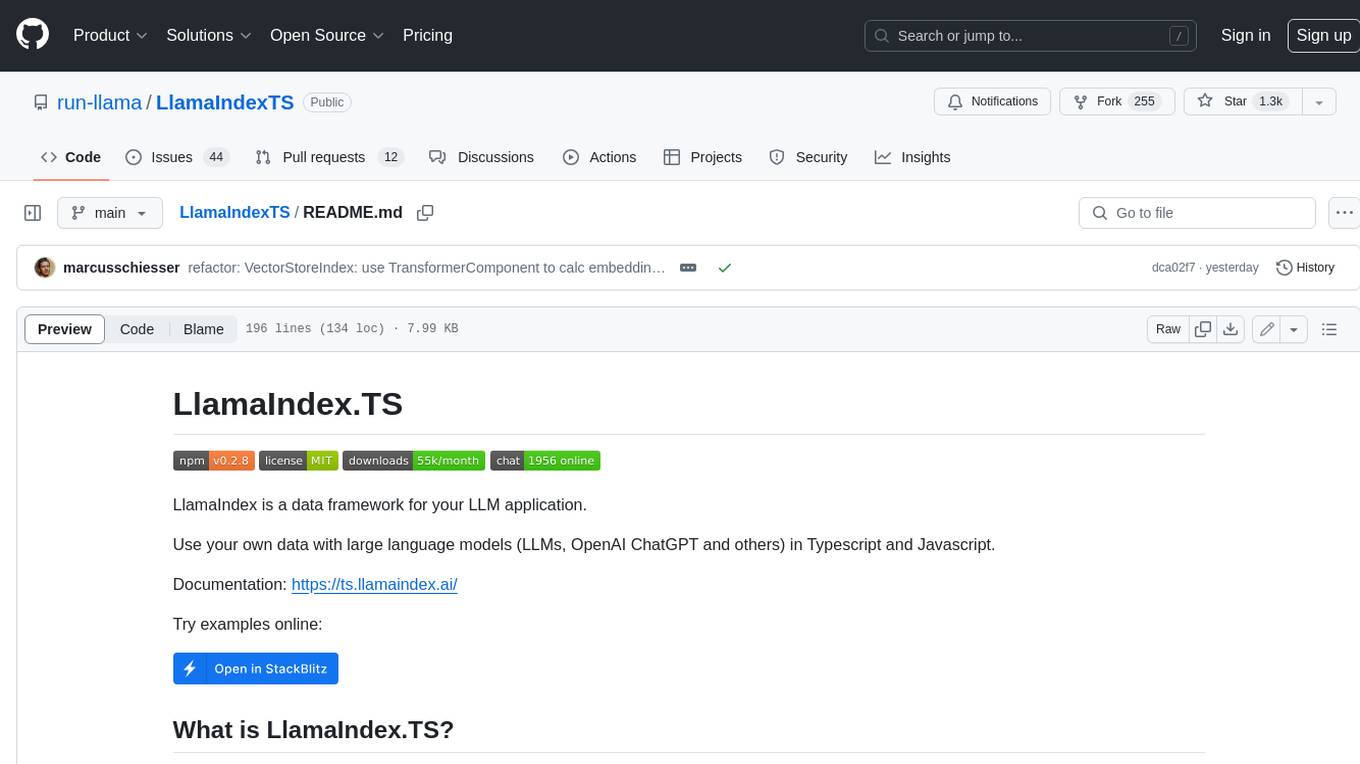
LlamaIndexTS
LlamaIndex.TS is a data framework for your LLM application. Use your own data with large language models (LLMs, OpenAI ChatGPT and others) in Typescript and Javascript.
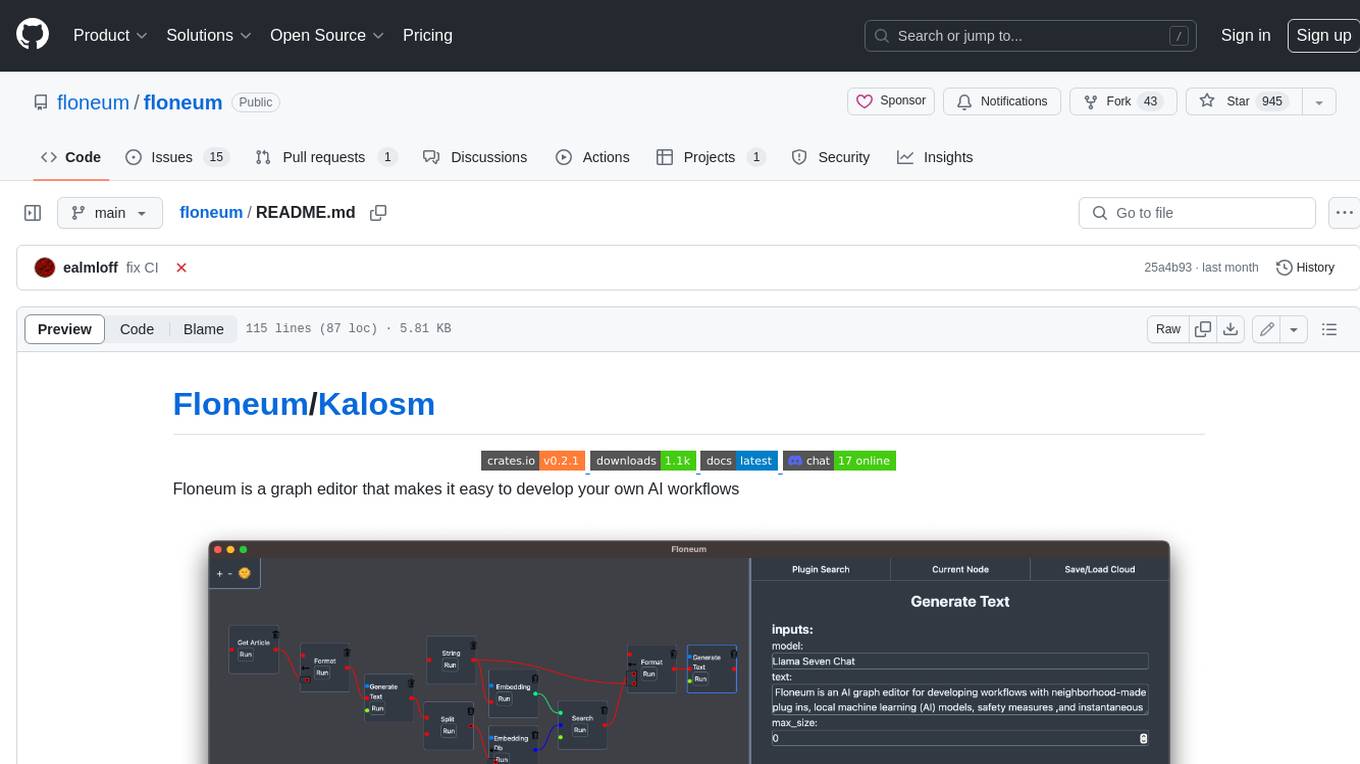
floneum
Floneum is a graph editor that makes it easy to develop your own AI workflows. It uses large language models (LLMs) to run AI models locally, without any external dependencies or even a GPU. This makes it easy to use LLMs with your own data, without worrying about privacy. Floneum also has a plugin system that allows you to improve the performance of LLMs and make them work better for your specific use case. Plugins can be used in any language that supports web assembly, and they can control the output of LLMs with a process similar to JSONformer or guidance.
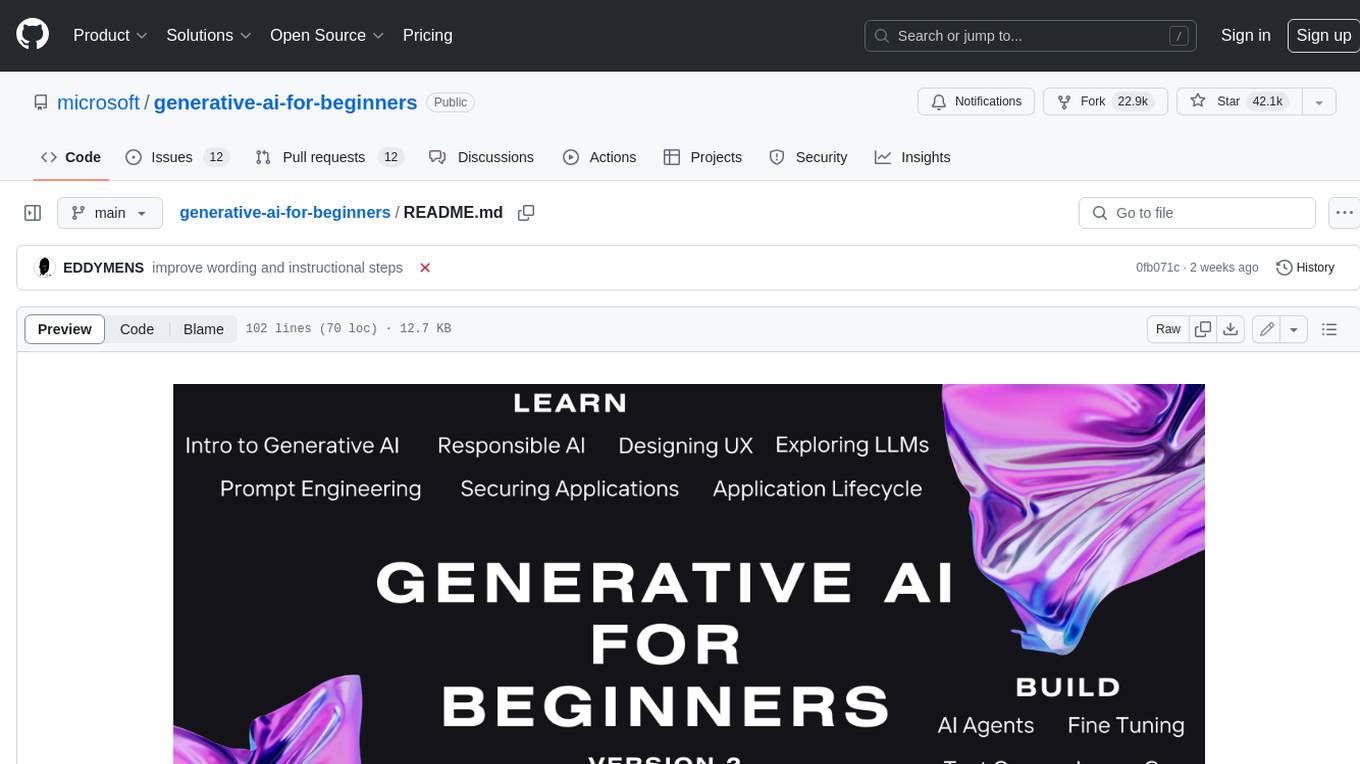
generative-ai-for-beginners
This course has 18 lessons. Each lesson covers its own topic so start wherever you like! Lessons are labeled either "Learn" lessons explaining a Generative AI concept or "Build" lessons that explain a concept and code examples in both **Python** and **TypeScript** when possible. Each lesson also includes a "Keep Learning" section with additional learning tools. **What You Need** * Access to the Azure OpenAI Service **OR** OpenAI API - _Only required to complete coding lessons_ * Basic knowledge of Python or Typescript is helpful - *For absolute beginners check out these Python and TypeScript courses. * A Github account to fork this entire repo to your own GitHub account We have created a **Course Setup** lesson to help you with setting up your development environment. Don't forget to star (🌟) this repo to find it easier later. ## 🧠 Ready to Deploy? If you are looking for more advanced code samples, check out our collection of Generative AI Code Samples in both **Python** and **TypeScript**. ## 🗣️ Meet Other Learners, Get Support Join our official AI Discord server to meet and network with other learners taking this course and get support. ## 🚀 Building a Startup? Sign up for Microsoft for Startups Founders Hub to receive **free OpenAI credits** and up to **$150k towards Azure credits to access OpenAI models through Azure OpenAI Services**. ## 🙏 Want to help? Do you have suggestions or found spelling or code errors? Raise an issue or Create a pull request ## 📂 Each lesson includes: * A short video introduction to the topic * A written lesson located in the README * Python and TypeScript code samples supporting Azure OpenAI and OpenAI API * Links to extra resources to continue your learning ## 🗃️ Lessons | | Lesson Link | Description | Additional Learning | | :-: | :------------------------------------------------------------------------------------------------------------------------------------------: | :---------------------------------------------------------------------------------------------: | ------------------------------------------------------------------------------ | | 00 | Course Setup | **Learn:** How to Setup Your Development Environment | Learn More | | 01 | Introduction to Generative AI and LLMs | **Learn:** Understanding what Generative AI is and how Large Language Models (LLMs) work. | Learn More | | 02 | Exploring and comparing different LLMs | **Learn:** How to select the right model for your use case | Learn More | | 03 | Using Generative AI Responsibly | **Learn:** How to build Generative AI Applications responsibly | Learn More | | 04 | Understanding Prompt Engineering Fundamentals | **Learn:** Hands-on Prompt Engineering Best Practices | Learn More | | 05 | Creating Advanced Prompts | **Learn:** How to apply prompt engineering techniques that improve the outcome of your prompts. | Learn More | | 06 | Building Text Generation Applications | **Build:** A text generation app using Azure OpenAI | Learn More | | 07 | Building Chat Applications | **Build:** Techniques for efficiently building and integrating chat applications. | Learn More | | 08 | Building Search Apps Vector Databases | **Build:** A search application that uses Embeddings to search for data. | Learn More | | 09 | Building Image Generation Applications | **Build:** A image generation application | Learn More | | 10 | Building Low Code AI Applications | **Build:** A Generative AI application using Low Code tools | Learn More | | 11 | Integrating External Applications with Function Calling | **Build:** What is function calling and its use cases for applications | Learn More | | 12 | Designing UX for AI Applications | **Learn:** How to apply UX design principles when developing Generative AI Applications | Learn More | | 13 | Securing Your Generative AI Applications | **Learn:** The threats and risks to AI systems and methods to secure these systems. | Learn More | | 14 | The Generative AI Application Lifecycle | **Learn:** The tools and metrics to manage the LLM Lifecycle and LLMOps | Learn More | | 15 | Retrieval Augmented Generation (RAG) and Vector Databases | **Build:** An application using a RAG Framework to retrieve embeddings from a Vector Databases | Learn More | | 16 | Open Source Models and Hugging Face | **Build:** An application using open source models available on Hugging Face | Learn More | | 17 | AI Agents | **Build:** An application using an AI Agent Framework | Learn More | | 18 | Fine-Tuning LLMs | **Learn:** The what, why and how of fine-tuning LLMs | Learn More |
For similar jobs

sweep
Sweep is an AI junior developer that turns bugs and feature requests into code changes. It automatically handles developer experience improvements like adding type hints and improving test coverage.

teams-ai
The Teams AI Library is a software development kit (SDK) that helps developers create bots that can interact with Teams and Microsoft 365 applications. It is built on top of the Bot Framework SDK and simplifies the process of developing bots that interact with Teams' artificial intelligence capabilities. The SDK is available for JavaScript/TypeScript, .NET, and Python.

ai-guide
This guide is dedicated to Large Language Models (LLMs) that you can run on your home computer. It assumes your PC is a lower-end, non-gaming setup.

classifai
Supercharge WordPress Content Workflows and Engagement with Artificial Intelligence. Tap into leading cloud-based services like OpenAI, Microsoft Azure AI, Google Gemini and IBM Watson to augment your WordPress-powered websites. Publish content faster while improving SEO performance and increasing audience engagement. ClassifAI integrates Artificial Intelligence and Machine Learning technologies to lighten your workload and eliminate tedious tasks, giving you more time to create original content that matters.

chatbot-ui
Chatbot UI is an open-source AI chat app that allows users to create and deploy their own AI chatbots. It is easy to use and can be customized to fit any need. Chatbot UI is perfect for businesses, developers, and anyone who wants to create a chatbot.

BricksLLM
BricksLLM is a cloud native AI gateway written in Go. Currently, it provides native support for OpenAI, Anthropic, Azure OpenAI and vLLM. BricksLLM aims to provide enterprise level infrastructure that can power any LLM production use cases. Here are some use cases for BricksLLM: * Set LLM usage limits for users on different pricing tiers * Track LLM usage on a per user and per organization basis * Block or redact requests containing PIIs * Improve LLM reliability with failovers, retries and caching * Distribute API keys with rate limits and cost limits for internal development/production use cases * Distribute API keys with rate limits and cost limits for students

uAgents
uAgents is a Python library developed by Fetch.ai that allows for the creation of autonomous AI agents. These agents can perform various tasks on a schedule or take action on various events. uAgents are easy to create and manage, and they are connected to a fast-growing network of other uAgents. They are also secure, with cryptographically secured messages and wallets.

griptape
Griptape is a modular Python framework for building AI-powered applications that securely connect to your enterprise data and APIs. It offers developers the ability to maintain control and flexibility at every step. Griptape's core components include Structures (Agents, Pipelines, and Workflows), Tasks, Tools, Memory (Conversation Memory, Task Memory, and Meta Memory), Drivers (Prompt and Embedding Drivers, Vector Store Drivers, Image Generation Drivers, Image Query Drivers, SQL Drivers, Web Scraper Drivers, and Conversation Memory Drivers), Engines (Query Engines, Extraction Engines, Summary Engines, Image Generation Engines, and Image Query Engines), and additional components (Rulesets, Loaders, Artifacts, Chunkers, and Tokenizers). Griptape enables developers to create AI-powered applications with ease and efficiency.



